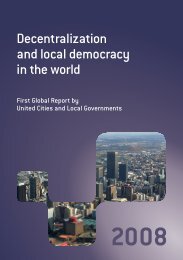Making Cities Resilient Report 2012
Making Cities Resilient Report 2012
Making Cities Resilient Report 2012
Create successful ePaper yourself
Turn your PDF publications into a flip-book with our unique Google optimized e-Paper software.
“Investments in disaster risk reduction and climate change<br />
adaptation can make Copenhageners healthier, protect<br />
biodiversity, improve quality of life, and make our city more<br />
economically resilient.”<br />
Ms. Ayfer Baykal, Copenhagen’s Mayor of<br />
Technical and Environmental Administration<br />
Maintaining natural defences<br />
Essential 8 emphasises the importance of natural barriers in mitigating hazard impacts. Many Campaign cities<br />
are focusing on environmental management measures to reduce risk, including planting and rehabilitating<br />
mangroves for coastal protection (Albay Province and San Francisco, Cebu, and Makassar), reinforcing<br />
sand dunes (Cape Town), planting trees to reduce wind damage to schools (Kampala), ridding wetlands of<br />
encroaching species (Kampala), afforestation in Pune to reduce flood risk), and protecting slopes to reduce<br />
the risk of landslides (Quito). Ecologically sensitive construction involves using natural materials to build<br />
structures that are hazard resilient. For example, Pune has built earthen check dams in hilly areas to help<br />
conserve the watershed and reduce flood risk (39). Another initiative in Saijo City constructed 22 dams from<br />
wood from thinned-out local forests and local rocks to prevent mudflows (48).<br />
Box 4.11 : Copenhagen implements Climate Plan after floods<br />
The Danish capital of Copenhagen implemented a sweeping climate change plan, backed by the national<br />
government, after the city was devastated by ‘a one in 1,000’ year flood in July 2011. The city’s Climate<br />
Plan is designed to limit the impacts of more severe weather and climate change. Among other points,<br />
the plan calls for a 20 per cent cut in carbon emissions by 2015, and a goal to be carbon neutral by 2025.<br />
Overall, Copenhagen estimates the Plan could deliver an estimated savings of €3 billion over the next 100<br />
years in avoided economic losses related to future extreme flooding from the sea and rain. Over the next<br />
century, rainfall on the city is expected to increase by 30 per cent, with intense late summer precipitation<br />
increasing by as much as up to 50 per cent.<br />
Box 4.12 : Integrating environmental sustainability and disaster risk<br />
reduction in Overstrand, South Africa<br />
As part of addressing broader challenges of environmental sustainability and community development,<br />
the municipality of Overstrand has sought to increase its resilience. Water scarcity is the primary risk in<br />
Overstrand and the local government’s water demand management strategy includes a public awareness<br />
campaign, leak detection and repair, introducing restrictions on water use and development, and the<br />
‘Working for Water’ project, in which disadvantaged groups are trained and employed to clear invasive<br />
alien plant species. This project seeks to promote biological biodiversity, increase water security, and offer<br />
livelihood opportunities Within South Africa, Working for Water has cleared more than one million hectares<br />
of invasive alien species and provided jobs and training to approximately 30,000 women, young people<br />
and people with disabilities. The Overstrand water resource management programme is the product of<br />
a multi-stakeholder partnership among national and provincial water agencies, a regional biodiversity<br />
conservation institute, and a group of community-based organisations. Key to the success and longevity<br />
of this are cross-scale and multi-sector contributions and the local government’s role as facilitator.<br />
60 | <strong>Making</strong> <strong>Cities</strong> <strong>Resilient</strong> <strong>Report</strong> <strong>2012</strong>

















